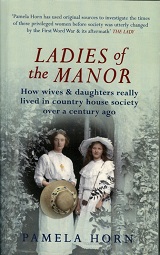Door Frieda Kreuer, research assistant
Denkmalwerte, Beiträge zur Theorie und Aktualität der Denkmalpflege
Ladies of the Manor, How wives and daughters really lived in country house society over a century ago
This presentation of the book of the month is different for several reasons. Not only because it is written in English, but also because it discusses two books instead of one. And even though their topics might be way too different from each other for a proper comparison, it is indeed this difference in how the issue of built heritage is approached that carries the potential for interesting conclusions. Is there something like a typical German or British approach to writing about the past?
Presenting a collection of academic essays ranging from more general topics like the aesthetic value of a monument to more specific case studies like the restoration of the Neues Museum in Berlin, the German publication provides a broad theoretical approach to the issue of heritage management. In a language that makes excessive use of complex terminology and neologisms like "Geschichtsvergessen und bildbesessen", the authors attempt to raise awareness for the importance of conservation and protection by addressing mainstream 21st century challenges like climate change and communication in the digital age.
This strictly theoretical and rational approach to history and its usage as heritage becomes especially apparent when put into comparison with the second object of this book discussion. In Ladies of the Manor, the focus is shifted away from the needs of historic buildings and their survival towards the people living inside them. More specifically, a group of people is taking centre stage which is rarely represented in this field of academic research: women. Using historical sources, the book describes in a simple, easily accessible language the lifetime stories of privileged women and their daily routines in country houses before the catastrophe of the First World War changed British society in general, including ideas about how a woman should lead her life.

And so one part of this book discussion provides a strictly rational perspective on the material value of monuments and the need to protect them, while the other tells a personal story of country houses as structures that were more than just their material, aesthetic or cultural value, but homes. Judging solely from these examples, it seems that the British take a much more emotional approach to their historical buildings than the Germans. Especially country houses take a special place in the memory of British society, as reminders of a time of imperial power, noble manners, and of a society with clear hierarchical structures. German academics, however, seem to struggle with this idealising look back. This tense relationship with the past is exemplified by the book`s chapter on Auschwitz. Much like the majority of German publications on heritage, the darkest part of the country`s past cannot be left unmentioned in order to avoid an all too positive tone.
Meier, Hans-Rudolf and Ingrid Scheuermann, Denkmalpflege: Beiträge zur Theorie und Aktualität der Denkmalpflege, Berlin, München, Deutscher Kunstverlag, 2010. (ISBN 978-3-422-06903-9), plaatscode NKS-biliotheek: dX1.76/DENK
Horn, Pamela: How Wives and Daughters Really Lived in the Country House Society over a Century Ago, Gloucestershire, Amberley Publishing, 2014. (ISBN 978-1-4456-1981-1), plaatscode NKS-biliotheek: enE6.1/HORN